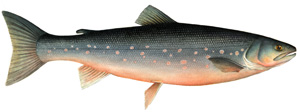Farmed Arctic char

Credit: Brenda Guild
Names:
Arctic Char or Arctic Charr (Salvelinus alpinus)
Locations:
Alberta, Manitoba, New Brunswick, Newfoundland and Labrador, Nova Scotia, Ontario, Quebec, and Yukon
Methods:
Juveniles: land-based hatchery facilities (flow through and recirculation)
Grow-Out: land-based systems (flow through and recirculation) and saltwater net pens
Broodstock: land-based (flow through and recirculation)
At a Glance
Freshwater Arctic char aquaculture is a small, but growing industry in Canada. As its name suggests, Arctic char thrives in cold water and so is suited to aquaculture in Canada’s North.
While the farming of Arctic char is still relatively young in Canada, the industry is diverse. Operators produce both eggs and mature fish. Arctic char eggs are exported to a number of countries eager to develop their own char industries, while the meat is sold both domestically and abroad. Arctic char aquaculture is benefiting First Nations and remote communities in Canada, economically and socially.
For more information on aquaculture’s impact, consult Communities and Employment.
Regulations
The Arctic char aquaculture industry is comprehensively regulated at the federal, provincial and territorial levels. Regulation of the industry helps to ensure sustainable farms and the environments in which they operate. Provincial and territorial governments have regulatory responsibilities in licensing sites and processing plants. Management of the aquaculture industry is based on science and also incorporates traditional and local knowledge.
Scientific Research
Scientific research is important for the responsible development of the Arctic char aquaculture industry in Canada. A number of innovative research initiatives have been undertaken by Fisheries and Oceans Canada, industry, academic and other government researchers to optimize Arctic Char growth performance and health, as well as environmental conditions in culture practices.
- Date modified: